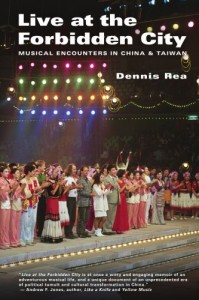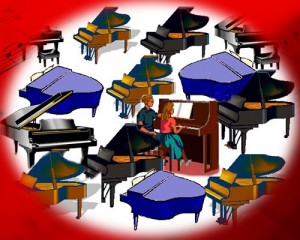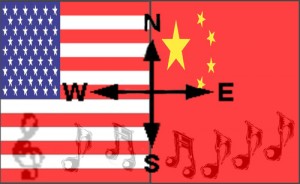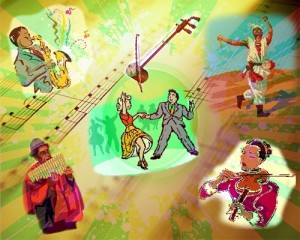Sometimes when two unlike musical cultures clash or at least come together something wonderful happens, as in the evolution of Afro-Cuban Jazz in mid-20th century in New York City. Sometimes, though, the opposite happens, especially if the prevailing political and cultural environment is unwelcoming.
An example of this is evidenced by the influence of European and, thereafter, American music, i.e., jazz, on traditional Chinese music. The description of this is provided by Dennis Rea—in his 2006 book Live at the Forbidden City–in a chapter devoted to his travels outside Chengdu a few months immediately following the trauma of Tiananman Square of June 1989.
He and his fiancée traveled to parts of northeast China where they encountered the music of the Uighurs. His commentary, though, also centers on the decline of traditional Chinese music beginning over 100 years ago in favor of European music (that still exists today). Later, in the 1920s, jazz becomes all the rage in China, particularly in Shanghai, then a blossoming economic center (that still is today). And in the 1990s American style pop/rock music becomes all the rage in China, especially in the larger  cities, such as Shanghai and Beijing.
cities, such as Shanghai and Beijing.
The Chinese traditionalists of the 1920s and 1930s railed against this continued western influence. I say “continued” because the reactionary attitude of these Chinese traditionalists to “outside influences” is rooted in similar attitudes that reach back many centuries, of which the Chinese response to Britain’s advances in 1793 and again in mid-19th century, i.e., the Opium Wars, are the most obvious examples. The Communists continued this attitude following their takeover on October 1, 1949. In this period, the eradication of outside western influences until Mao’s death on September 9, 1976 is extreme.
This raises the question of the relationship between the fine and performing arts on political and economic systems. A knife, sword, or bullet can kill, but can a line of poetry, a dance, or song have the same power? Is the pen mightier than the sword? How can a picture, movement, or sound elicit so much fear in a political system that that political system feels the need to squash the life out of its aesthetic existence?
Rea commented on these issues:
“The traditional music of China’s Han majority hasn’t fared much better than that of the Uighurs under communist rule. Like the nation itself, Chinese music for centuries successfully assimilated elements of other Asian cultures while retaining its own distinct identity. In contrast, China’s encounter with European classical music had a devastating effect, as the alien science of functional harmony clashed with the essentially non-harmonic methodology of Chinese musical practice. When confronted with the imposing edifice of European music theory, many Chinese musicians denigrated their own music as unsophisticated by comparison. By the late 1890s, China’s national instruments were falling out of favor with the musical elite, victims of the country’s love affair with that embodiment of Western musical hegemony, the piano, and to a slightly lesser degree the violin. Despite the best efforts of propagandists to outlaw Western art forms during the Cultural Revolution, this obsession with European music continues to this day and remains the focus of formal music education in China.”
 What Rea says is true, not just of formal music education in the conservatories, but outside the conservatories. Both in Beijing and Shanghai, one only has to go to one of the modern Macy’s Department Store-like multi-story department stores and on one floor you are bound to come across a whole section devoted to all kinds of pianos. Not Steinways or Yamahas, mind you, but there’ll be plenty of styles to choose from. During one visit to just this kind of store in Beijing, I observed these demonstration pianos being put to very good use: a mother was giving her young daughter a lesson, or perhaps she was taking the opportunity for the young, budding pianist to practice her lesson before a lesson with a real teacher. Either way, the mother was relentless, a counterpoint to the daughter’s glaring lack of real talent.
What Rea says is true, not just of formal music education in the conservatories, but outside the conservatories. Both in Beijing and Shanghai, one only has to go to one of the modern Macy’s Department Store-like multi-story department stores and on one floor you are bound to come across a whole section devoted to all kinds of pianos. Not Steinways or Yamahas, mind you, but there’ll be plenty of styles to choose from. During one visit to just this kind of store in Beijing, I observed these demonstration pianos being put to very good use: a mother was giving her young daughter a lesson, or perhaps she was taking the opportunity for the young, budding pianist to practice her lesson before a lesson with a real teacher. Either way, the mother was relentless, a counterpoint to the daughter’s glaring lack of real talent.
Rea also comments on the inevitable fusion of traditional Chinese folk melodies with Western musical approaches:
“While China has produced an impressive number of virtuoso performers in the European tradition, the national infatuation with European music has also spawned an unfortunate forced fusion of Chinese folk melodies with Western orchestration. Though a source of great pride to ardent nationalists, such lightweight, European-influenced works as the “Yellow River Concerto” and “The Butterfly Lovers” with their puerile patriotic melodies and cloying “101 Strings” romanticism, combine the worst of both worlds. Not until the emergence in the 1980s of fiercely imaginative “New Tide” composers such as Tan Dun [of “Crouching Tiger” fame] and Guo Wenjing did  China’s embrace of Western musical values produce a mutually enriching synthesis of the two traditions, rather than mere pastiche.”
China’s embrace of Western musical values produce a mutually enriching synthesis of the two traditions, rather than mere pastiche.”
Rea continues:
“Another factor in the decline of traditional music was the official cultural policy of the Chinese Communist party. For decades after the 1949 communist revolution, music’s sole purpose was to be a transmitter of political and moral propaganda. Party idealogues condemned China’s rich classical and folk music heritage as representative of feudalist “old thinking” and individual initiative was subsumed in the long march toward a utopian socialist society. The only officially sanctioned musical genres the post-Liberation period were politically correct socialist anthems, Madame Mao’s dour revolutionary operas, and feel-good ditties extolling the praises of the Motherland. Not surprisingly, the public never really warmed to utilitarian music that dull as day-old bread. Only after Deng Xiaoping relaxed constraints on popular music in the late 1970s did Chinese music begin to wiggle out of its idealogical straitjacket. Traditional music performance and research resumed, romantic love songs were again tolerated, and foreign styles such as rock and disco first appeared in China, engendering new East-West fusions. Among the more bizarre hybrids was a series of recordings of Cultural Revolution songs set to a thumping disco beat, with singers belting out incongruous lyrics.”
In a way the importation of European classical music and American jazz has created a cultural dichotomy in China. Some have embraced the non-traditional music, others are holding on to the “traditional” melodies for dear life.
Nothing stays the same forever. Resistance to outside influences only serves to weaken the cultural gene-pool, so to speak. On the other hand, there is something to be said for preserving and honoring past cultural traditions. Both have value.
Please write to me at meiienterprises@aol.com if you have any comments on this or any other of my blogs.
Eugene Marlow, Ph.D.
June 2, 2014
© Eugene Marlow 2014


